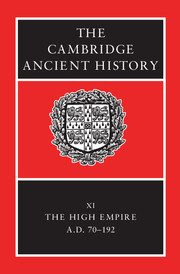Book contents
- Frontmatter
- PART I NARRATIVE
- PART II GOVERNMENT AND CIVIL ADMINISTRATION
- PART III THE EMPIRE
- 8 Frontiers
- 9 The army
- 10 Local and provincial institutions and government
- 11 Rebels and outsiders
- PART IV ROME, ITALY AND THE PROVINCES
- PART Va ECONOMY AND SOCIETY
- PART Vb ART AND CULTURE
- Chronological Table
- BIBLIOGRAPHY
- Index
- 1 The Roman world in the time of Marcus Aurelius
- 7 The Danube provinces
- References
11 - Rebels and outsiders
from PART III - THE EMPIRE
Published online by Cambridge University Press: 28 March 2008
- Frontmatter
- PART I NARRATIVE
- PART II GOVERNMENT AND CIVIL ADMINISTRATION
- PART III THE EMPIRE
- 8 Frontiers
- 9 The army
- 10 Local and provincial institutions and government
- 11 Rebels and outsiders
- PART IV ROME, ITALY AND THE PROVINCES
- PART Va ECONOMY AND SOCIETY
- PART Vb ART AND CULTURE
- Chronological Table
- BIBLIOGRAPHY
- Index
- 1 The Roman world in the time of Marcus Aurelius
- 7 The Danube provinces
- References
Summary
INSIDERS AND OUTSIDERS
Introduction
The Roman state of the first and second centuries was a political unit of unprecedented scale in the West, with, I believe, over eighty million inhabitants. The boundaries of this feat of political unification, however, were not coterminous with anything that could reasonably be called a ‘Roman society’. The empire was a militarily created hegemony of immense land mass that harboured hundreds, if not thousands, of different societies. These two fundamental and contradictory facts – massive unity and diversity – must be grasped before any understanding of the problem can be attained. Aelius Aristides, a good example of one of those local aristocrats who were integrated into the political mainstream of the empire in the midsecond century by means of citizenship, and who praised the empire for its integrity, its unparalleled perfection, was still compelled to deny the obvious:
“Vast and comprehensive as is the size of it, your rule is much greater for its thoroughness than it is for the area its boundaries enclose. For the Mysians, Sakai and Pisidians do not maintain any rule inside it, nor are there any lands held by others who have occupied them by force or detached them by revolt, and who cannot be captured.”
- Type
- Chapter
- Information
- The Cambridge Ancient History , pp. 361 - 404Publisher: Cambridge University PressPrint publication year: 2000
References
- 28
- Cited by

